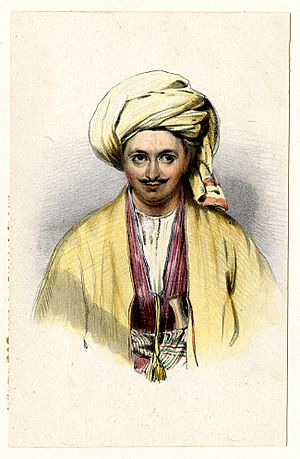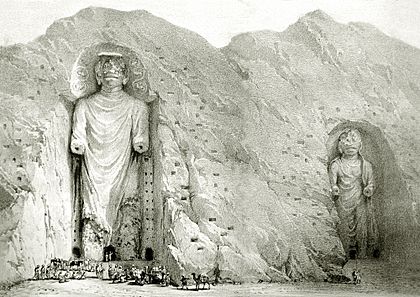Alexander Burnes facts for kids
Quick facts for kids
Alexander Burnes
|
|
|---|---|

Sketch by Vincent Eyre
|
|
| Born | 16 May 1805 |
| Died | 2 November 1841 (aged 36) |
| Relatives | James Burnes (brother), Robert Burnes (cousin) |
| Awards | Royal Geographical Society's Founder's Medal (1835) |
Sir Alexander Burnes (born May 16, 1805 – died November 2, 1841) was a Scottish explorer, soldier, and diplomat. He was a key figure in a big rivalry between the British and Russian empires over control in Central Asia, often called 'The Great Game'. People called him Bokhara Burnes because he helped the British connect with and explore the city of Bukhara. His book, Travels into Bokhara, was very popular when it came out in 1835.
Contents
Early Life and Career
Alexander Burnes was born on May 16, 1805, in Montrose, Scotland. His father, James Burnes, was the local leader, and his cousin was the famous poet Robert Burns. Alexander also had a brother named James, who became a doctor.
When he was sixteen, Alexander joined the army of the British East India Company. This company was very powerful and helped Britain rule parts of India. While serving in India, Alexander quickly learned Urdu and Persian. Because of his language skills, he became an interpreter in Surat in 1822.
In 1826, he moved to Kutch, where he worked for three years. He became very interested in the history and geography of the areas around India, especially places the British hadn't explored much yet. This interest soon led him to Afghanistan.
Exploring Central Asia
Afghanistan was a remote country located between the powerful British and Russian empires. Both empires were trying to expand their influence. The British worried Russia wanted to move into India, and the Russians feared Britain would move north through Afghanistan. To understand what was happening, the British government sent Burnes to gather information.
Journey to Bukhara
In 1831, Burnes traveled in disguise through Kabul to Bukhara. He wrote the first detailed reports about Afghan politics. He also suggested exploring the Indus River valley, which was approved. In 1831, his and Henry Pottinger's surveys of the Indus River helped prepare the way for future British actions in the Sindh region, opening a path towards Central Asia.
Later that year, he arrived in Lahore with a gift of horses from King William IV for Maharaja Ranjit Singh. The British said the horses couldn't travel by land, so they were allowed to transport them up the Indus River. This gave Burnes a secret chance to map the river. Burnes chose not to have a military escort, as he didn't want local people to think the British were planning an invasion. Instead, he traveled with only one other British officer and hired local people to help navigate. This way, Burnes built good relationships with local leaders. His excellent diplomacy skills helped him travel through areas of the Indus that were usually closed to Europeans.
Meeting the Maharaja
In October 1831, Burnes helped arrange the first meeting between Maharaja Ranjit Singh and the British Governor General of India, Lord William Bentinck. This important meeting took place near the Sutlej River. Many British officials attended, and the Maharaja proudly showed off the famous Koh-i-Noor diamond. This jewel later became part of the British Royal Family's collection.
After this meeting, Burnes stayed briefly in Delhi. There, he met Mohan Lal, who would become his travel partner. Burnes was very impressed by Lal's knowledge of world geography. From Delhi, Burnes went to Ludhiana, where he got permission to continue his travels into Central Asia.
In the years that followed, Burnes and Mohan Lal traveled through Afghanistan, crossed the Hindu Kush mountains, and reached Bukhara (in modern-day Uzbekistan) and Persia.
Sharing His Discoveries
When Burnes visited England in 1834, he published his travel stories. This book greatly increased what people knew about these countries and became very popular. It earned him a lot of money, and he received awards from important groups like the Royal Geographical Society in London and Paris. He was also made a Fellow of the Royal Society.
After returning to India in 1835, he worked to get a treaty for ships to use the Indus River. In 1836, he went on a diplomatic mission to Dost Mohammed Khan in Kabul.

First Anglo-Afghan War
Burnes advised Lord Auckland, the British leader, to support Dost Mohammed as the ruler of Kabul. However, Lord Auckland chose to follow another advisor, Sir William Hay Macnaghten, and instead put Shah Shuja back on the throne. This decision led to the start of the First Anglo-Afghan War.
When Shah Shuja became ruler again in 1839, Burnes became a political agent in Kabul. He was made a knight by Queen Victoria in 1838. He stayed in Kabul until he was killed in 1841 during a rebellion. His younger brother, Charles, was also killed. Burnes was known for staying calm even when his life was in danger.
Years later, in 1860, it was discovered that some of Burnes's reports from Kabul in 1839 had been changed to make it seem like he had different opinions. However, the British government refused to investigate this. Another book about his later work, Cabool: A Personal Narrative, was published in 1842.
Final Months and Death
On August 7, 1839, the British government put Shah Shuja back on the throne in Kabul. Shah Shuja had been living in exile for over thirty years and was seen as someone who would cooperate with British interests.
Burnes had believed Shah Shuja was not fit to rule and had urged Lord Auckland to support Dost Mohammad Khan instead. But his advice was ignored. Dost Mohammad surrendered to British forces in November 1840 and went into exile in India. Even though Burnes didn't support Shah Shuja, he was made a political officer in Kabul, a job he didn't enjoy.
Shah Shuja's rule in Kabul was harsh, and many Afghans became very poor. He treated his own people badly and sought revenge on those he felt had betrayed him.
At the same time, many British officers, their families, and staff moved to Kabul because of its cooler weather. The British brought new customs like cricket and skating. This sudden increase in people caused food and goods prices to rise sharply. Shah Shuja also increased taxes, leading to widespread economic problems for the local people.
Shah Shuja asked the British troops to move their camp outside the city walls. However, Burnes chose to stay inside the old city in a walled house with his brother Charles and other officers.
On November 1, 1841, Mohan Lal warned Burnes about a plot to kill him and urged him to leave the city. Many Afghans blamed Burnes for the city's financial and religious problems. Burnes felt confident he could calm any trouble and stayed in Kabul. That night, a small group started gathering a mob, spreading the false rumor that the building next to Burnes's house held money for the entire British army.
By nightfall, a large crowd had gathered in Burnes's house courtyard. Burnes sent a messenger for help and tried to talk to the crowd from his balcony. Help from the British army was delayed because officers argued about how to respond.
The situation worsened as the rioters set fire to the stables. A shot was fired, and Major Broadfoot, standing next to Burnes, was killed. Realizing there was no hope of rescue, Charles Burnes went into the courtyard, fighting, and was killed. Alexander Burnes was then attacked and killed by the mob. These events happened very close to where the British troops were stationed. An officer later wrote that 300 men might have been enough to stop the riot in the morning, but 3,000 would not have been enough by the afternoon.
Legacy
Alexander Burnes is remembered in the name of a bird, the rufous-vented grass babbler, which is scientifically called Laticilla burnesii.
Historical Stories Featuring Burnes
- Fraser, George MacDonald, Flashman. 1969.
- Hensher, Philip, The Mulberry Empire. 2002.
- Henty, G. A., To Herat and Cabul, A Story of the First Afghan War. 1902.
- Assassin's Creed Chronicles: India

